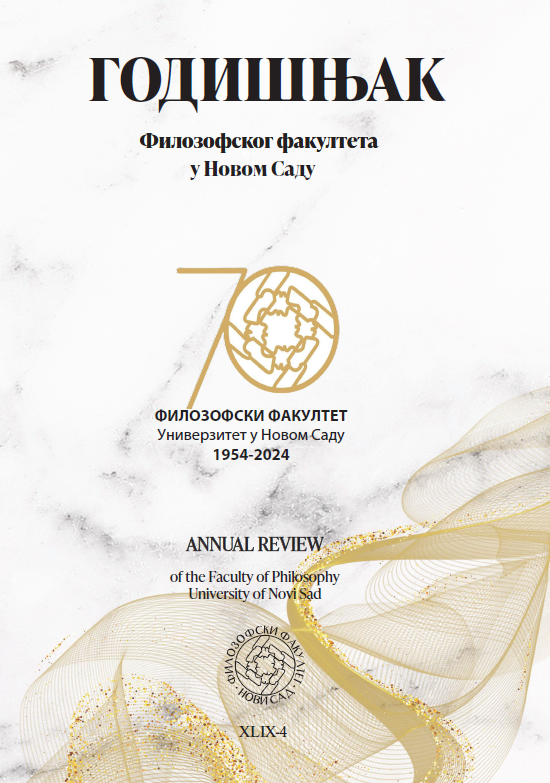THE VERIST VERGA IN CONTEMPORARY MUSIC
Главни садржај чланка
Сажетак
Between the end of the 20th century and the new millennium, while the critical debate on Giovanni Verga seemed to weaken and at the same time his influence on contemporary literature diminished, numerous artists in the musical world drew from the experimentalism inherent to the Catanian writer’s verist oeuvre. Through performances that combined theatre, dance, and music, often involving contaminations among different styles, the works of verist Verga transcended the geographical boundaries of Sicily to reach the ‘Big Apple’ and even reverberated in expressive pop-culture forms, including pop music, combining more traditional pieces in Sicilian dialect with rap sounds. Although the choice of musical works presented in this paper is limited to those based on the novel I Malavoglia and a few short stories, within this corpus containing various reinterpretations by contemporary artists one can find stylistic and thematic inspirations that reflect the cornerstones of Verga’s expressive innovation. This is, therefore, a tangible sign that the Etnean author, through the experimentation of his verist workshop, remains relevant in contemporary times.
Downloads
Детаљи чланка
Референце
Alfieri, G. (1980). Innesti fraseologici del siciliano nei Malavoglia. Bollettino del Centro di Studi Filologici e Linguistici Siciliani, 14 (1980), 221–295.
Alfieri, G. (2016). Verga. Roma: Salerno editrice. Alfieri, G. – Riccardi, C. (2020). Scrittura «lenticolare» e stile reticolare: cosa rivela l’Edizione Nazionale di Giovanni Verga. Oblio, X(40), 14–30. https://www.progettoblio.com/archivio/oblio-x-40/ Anastasio, M. (2015, 24 March). Rosso Malpelo. YouTube. https://youtu.be/lA2ws6fvlI0 Asor Rosa, A. (ed.) (1972). Il caso Verga. Palermo: Palumbo.
Baldi, G. (1980). L’artificio della regressione. Tecnica narrativa e ideologia nel Verga verista. Napoli: Liguori.
Battiato, L. (2013, 26 July). Mena tra melodia pop e lirica. Globus magazine. https://www.globusmagazine.it/
Cadioli, A. (1998). La ricezione. Roma–Bari: Laterza.
Caparezza (2006). Ninna nanna di Mazzarò.
YouTube . https://g.co/kgs/Mm6uB3
Caturegli, A. F. (1982). Tradu
ttori del Verga in lingua inglese. Italianistica: Rivista
di Letteratura Italiana , 1 , 35 47.
Ceronetti, G. (1982). La vita apparente. Milano: Adelphi.
De Simone, V. (1948) La lupa. In Berretti, A. (2013), Libretti di opere siciliane. Altervista. 1–9. http://librettisiciliani.altervista.org/wpcontent/uploads/2019/03/LupaDeSimoneSantonocito-1.pdf
De Vito, A. J. (1941). The struggle for existence in the work of Giovanni Verga. Italica, XVII. 179–185. DOI: https://doi.org/10.2307/476186
Farinotti, P. (2023). Dizionario di tutti i film. Milano: Booktime.
Ferro, G.
Miano, M. (2015, 17 No vember). La Lupa. Note. Teatro Quirino
Gassman . https://www.teatroquirino.it/eventi/la lupa 2015 11 17/
Garozzo, F. (2010, 31 January). I Malavoglia. YouTube. https://youtu.be/n8a5-VEbwss
Luperini, R. (1976). Verga e le strutture narrative del realismo. Saggio su “Rosso Malpelo”. Padova: Liviana.
Luperini, R. (2005). Verga moderno. Bari: Laterza.
Mazzone, A. (2004).
La roba, i galantuomini, gl’innamorati . Mazzone, G. &
Mazzone, G. ( eds.). Catania: Prova d’Autore
Mazzone, G. (2015, 3 September). L’avvicinamento, YouTube. https://youtu.be/uv_NbGopr3Q
Nocetti, G. (2016, 17 November). I Malavoglia. YouTube. https://youtu.be/s0N4CB6nKL8
Ojetti, U. (1985). Alla scoperta dei letterati. Milano: Dumolard. https://books.google.it/books/about/Alla_scoperta_dei_letterati.html?id=l11_nQEACAAJ&redir_esc=y
Oliva, G. (2007). Capuana, Verga e il progetto teatrale verista. Il teatro verista, tomo I. 27- 39.
Oliva, S. (2013). Opera popolare. In Gregory, T. (ed.). Lessico del XXI secolo, Appendice VIII, vol. II. Roma: Istituto dell’Enciclopedia Italiana.
Parenti, P. (2022). “Cavalleria rusticana” Tribolazioni d’autore: Vicende di riscritture della novella verghiana tra letteratura e altre arti. Testo e Senso, 24, 143-51. doi:10.58015/2036-2293/587
Quaresima, L. (1988). La scure, il rogo (e il fucile): “La Lupa”, da Verga a Lattuada. Annali d’Italianistica, 6, 123–147. http://www.jstor.org/stable/24004194
Riccardi, C. (1984). Introduzione a G. Verga. In Verga, G. (1984). Tutte le novelle. Riccardi, C. (ed.). Milano: Mondadori, V-LXVI.
Tellini, G. (2022). Verga e il Novecento. In: Forni, G. (ed.) (2022). Verga e il verismo. Roma: Carocci. 277–289.
Venturini, M. (2006, 20 April). Un calabrese nella Big Apple. Chi è di scena [RaiTre]. Roma: Archivio Rai.
Verga, G. (1881). Vita dei campi. Milano: Treves.
https://archive.org/details/VitaDeiCampi/page/n7/mode/2up
Verga, G. (1883). Novelle rusticane. Torino: Casanova. https://it.wikisource.org/wiki/Novelle_rusticane
Verga, G. (1979). Lettere sparse. Finocchiaro-Chimirri, G. (ed.). Parma: Bulzoni.
Verga, G. (1982). The She-Wolf and Other Stories. Translated with an introduction by Giovanni Cecchetti. Berkeley-Los Angeles-London: University of California Press.
Verga, G. (1984). CarteggioVerga-Capuana. Raya, G. (ed.). Roma: Edizioni dell’Ateneo.
Verga, G. (2004). Carteggio Verga-Rod. Longo, G. (ed.). Catania: Fondazione Verga.
De Blasi, M. (2016). Verga a scuola, tra grammatiche e antologie. Italiano LinguaDue, 1, 403–413.





